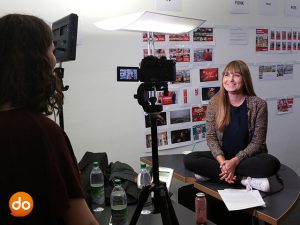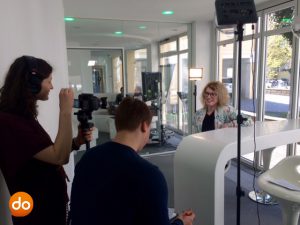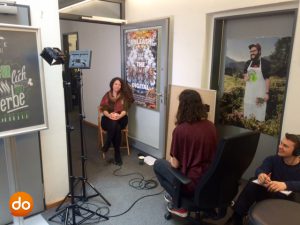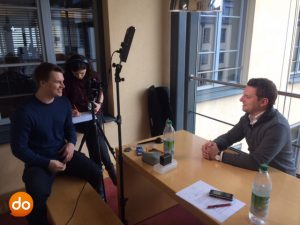As the old year comes to an end, the time comes to take a look to the future. The experts from the Serviceplan Group put together their personal favourite communication trends for the year 2016.
Florian Haller, CEO, Serviceplan Group
To inspire consumers, the marketing of the future has to create worlds of experience in which engrossing “Customer Experiences” ensure long lasting customer relationships. For marketing this change means, among other things:
1. Away from the “14-to-49-years” mindset – toward micro-segmentation and personalization
Because consumers move individually in the new consumer and media world, media planning with broad categories such as “14 to 49” can no longer achieve a lot. In future target groups based on socio-geographic data and ranges will be replaced by the analysis of stages of life, needs, and the experiences of each individual consumer. To accompany personalization through media planning, we need more than ever to focus on methods such as micro-segmentation.
2. Away from the channel perspective – towards “customer journey” accompaniment
Today, consumers use more channels, contact points and marketing resources for their purchases than ever before. Their “customer journey” is now many times more complex than it was even ten years ago. It is no longer a question of online or offline but of the mixture thereof. According to studies, so far few companies have really looked at their customers’ journeys.
3. Away from the advertising message towards relevant content offers
Exaggerated advertising claims no longer match the purchasing behaviour of the present because consumers believe nothing at face value. Up to 90 percent of purchasers have already done their product research before they visit a store (Forrester). So companies need to develop ideas on how they can support potential customers at an early stage with information and convincing arguments.
4. Away from technology focused data analysis – towards the use of data for customer satisfaction
In future it will not be about hoarding data for advertising purposes. Instead, companies will need to consider how they can use information to shape their business model, improve their products – and ultimately make their customers happy. The intelligent use of data will be decisive. This new strengthened position can only be achieved by dumping outdated mechanisms and tactics – and instead having the courage to venture a new beginning. The consumers will be grateful.
Ronald Focken, Managing Director, Serviceplan Group
1. Agencies must start consulting for digital transformation in order to prevail against new competitors from the consulting side.
Today Deloitte Digital has a worldwide turnover of 1.5 billion US dollars and is placed 11th in agency rankings. Accenture, Deloitte & Co. are going into the agency market to fight for our budgets. They have better access to customers because they have direct contact to the CEOs. However agencies can also win strategic projects in this growth area, and have the chance to improve their profitability. Agencies which do not invest here are losing opportunities to improve their reputations as well as long-term customer relationships.
2. Facebook, Google and Co. will become agency competitors and also sell creative services.
Many continue to claim the opposite, but the issue will arise – if not in 2016, then in 2017 or 2018. Direct distribution channels to customers are increasingly being forged. Google is not only at the Cannes Festival with a large stand because of the creatives, but also because of the large branded manufacturers. Selling of creation is already common in the United States. There, large agencies compete against the creative departments of social media companies. Facebook and Google offer creative concepts, and are getting business because social media has become one of the main channels for customers.
3. The idea no longer pays, complexity will increase and so profitability will continue to decline.
The big trend could therefore be to counter this by bringing together the power of agency associations for a stronger voice in politics and business. So far, only the Association of PR agencies is taking a stance and providing with Pitch-Block and the certification of pitch consultants for new rules.
Wolfgang Bscheid, Managing Director, Mediascale
Data-driven campaign management will be a big issue in the coming year – both in the media and in creation. This trend is being driven by several factors. Firstly, programmatic reach extension is increasing making data-based media buying much easier again. Our new platform solution PREX (Programmatic Exchange) gives our customers all available reach sources options automatically bundled for individual campaigns. In conjunction with CORE and NERO, our analysis and targeting products, both internal and external data can thereby be used for accurate reach selection and creative assignment. On the other hand, customers now know from their own experience what added value data can do, and so they now press for the use of profiles data for media selection.
However, creation will have to face this challenge next year significantly more intensively than it has done this year. I am very sure that the active participation of our creative elites will provide a huge boost in this matter. So hopefully next year we will see what is really possible when modern media control technology and great design get together.
Stephan Enders, Head of Mobile, Plan.Net Group
1. The invisible Web
Internet growth is unstoppable and consumer demand for apps unbroken. However, it is time to take a U-turn: the example of Apple reveals this in the fact that they provide an increasing number of interfaces between native apps and operating systems, so making new widgets possible. Based on personal preferences, places or situations you access relevant information and functions in your calendar day overview, push notifications, or even on your search page, and all this without having to open the app itself. The native app is increasingly merely a “base station” on your smartphone. The possibilities of native apps are thus paving the way for how we will deal with future digital content. Relevant content will find us. Websites and apps, as we know them will fade into the background.
Closely connected to the invisible web is the increasing:
2. Digitalization of our environment
and thus the associated additional networking of our connected mobile devices. The Web of Things will come to life and thus the exchange of information from device to device will become more relevant. First and foremost is the suitability of beacons for doing several tasks. Already, simply by their existence, we are able to track passage frequencies through open Bluetooth interfaces and thus utilise this passive use of technology for the optimization of sales areas. It can be used for indoor routing systems and for the careful use of exclusive offers via push information. And finally, beacons are also suitable for authentication in mobile payment systems and access control. After Apple exclusively achieved dominance with the introduction of “iBeacons”, Google followed with its open system Eddystone and Facebook is bringing in its own hardware. The latter is distributed free to shopkeepers to give a spatial meaning to Facebook Likes. Thus stores can succeed by using Facebook app push notifications in relating their own product Likes to smartphones and thus perform hit-sure referral marketing on the basis of personal data. Of course, beacons are not all-purpose wonder weapons but, used wisely, they are perfectly suited for the digitalization of our environment. So 2016 will also be a beacon year!
3. Chat is back. And augmented reality refuses to die!
Lately a number of new chat-based services have emerged. The makers addressed the question: What do users already use intensively? The answer? All forms of chat, Messenger and SMS applications, devoid of any frills, concentrating on the essentials. One example is the concierge service “Mission Control” by Lufthansa. The range of such services will grow in 2016 with certainty. And Augmented Reality (AR) experiences will have a renaissance. In the meantime, in some areas, for example as with instructions via AR glasses for automotive repairs, the technology has already found its place. Now the renowned “New York Times” has (re)discovered the strengths of augmented reality for journalism, and augmented individual reports with 360-degree insights into report locations. Thus readers can literally immerse themselves in the action area, not with costly new hardware purchases, but with their smartphones, and Google Cardboard from the finest papier-mâché for five euros. That immersion is not only restricted to journalistic worlds, but also to brand worlds, is self-evident.
Thorben Fasching, Marketing & User Experience Director, hmmh
From the multi-touchpoint trade perspective three topics will come to the fore in 2016.
Firstly: Off- and online will continue to grow together. The shopping behaviour of many customers is forcing traders not only to expand their digital business, but also to advantageously connect their touchpoints with customers to guarantee an uninterrupted shopping experience.
Secondly: It is also increasingly recognized here that intelligent CRM activities, including through the use of BI systems, can already partly run local one-to-one marketing campaigns in real time. This leads to a significant optimization of cost per new customer, so that conversion rate optimization will almost automatically experience a renaissance in 2016.
Thirdly: Despite convergence, native applications are increasingly becoming the surprise winners. Already declared dead two years ago, as traffic moved to mobile browsers, today, around the world, 80 percent of mobile traffic is attributable to native applications. Even transactional business is increasingly observed here.
Tobias Grewe, Partner, Serviceplan Köln
From employer branding to applicant experience – companies become applicants
The term “applicant” no longer applies only to the eligible job seekers, but equally to companies which seek highly skilled professionals and whose business success depends on their success in the battle for the best talent. Eligible job seekers are scarce and have now become “critical consumers”. Companies now need to apply to these coveted talents rather than vice versa. Candidates do not just want credible insights into the working environment of a company, but also quick access to relevant and authentic information and, above all, transparency with regard to the handling of their uploaded applications. So it is no longer just about the application process, but also about creating, as potential employers, a positive “applicant experience” – comparable to the customer journey we know from brand and product communication. “Make them care and make them buy” is the goal. To achieve this, the challenge is to make employers’ content with the right employer story perceptible at all relevant touchpoints in the information, application and negotiation phases – from job ads or careers pages to touchpoints which often do not take communication concepts into account, such as fast feedback on applications or even acceptance or rejection communications.
A change in thinking is taking place or must take place soon. A refusal must therefore no longer be a rejection, but, perhaps, more of a thank you, connected with an invitation into the company’s talent pool. Even candidates who you have to reject are often underestimated multipliers for the company’s image. In the digital world and its associated evaluation forums, bad experiences are communicated quickly. This holistic view is important for the development of future employer branding concepts which is important for a coherent applicant experience regardless of whether it leads to employment or rejection.
Rami Hmadeh, Managing Partner, Serviceplan Middle East
Trends 2016 – It’s all about personalized experiences.
The consumer in the Middle East continues to desire and respond to highly individual marketing and advertising. The fact that they want to be wowed, courted, heard, understood and appreciated at any touchpoint of a unique customer journey also explains why Me-Commerce keeps growing in importance. Consumer-to-consumer communication on social media platforms, immediate access to content through mobile as well as beacons and near-field communication are becoming stronger triggers to drive purchase decisions – simply because they satisfy a growing demand for personalised shopping experiences. Accordingly, content marketing is on the rise, too. In 2016, 60 percent of marketers in the Middle East are said to increase their content marketing budgets, with more than 30 percent of them planning to spend up to a half of their digital budget on it. The challenge will be to create and distribute content that is valuable, relevant and attractive enough to retain a clearly defined audience – and, ultimately, to drive profitable customer action. This is where ‘Big Data’ will continue to play a decisive role, however we’re talking more about the ‘right’ rather than ‘big’ data. It goes all back to being truly personal, individual and authentic. Marketers who manage to establish an on-going conversation with their target customers with the right content on the right touch-points will definitely be on top of the trend in 2016.
Manfred Klaus, Board Spokesperson, Plan.Net Group
For 2016, I see three trends, in which we should invest in the long term. Content competence will be a key success factor in brand communication in 2016. Only those who appreciate relevant content for the target group (for whom and why?), creation-management and content generation (what and how?), as well as controls content management and distribution (where, how often and how much?), can achieve sustainable success.
Extensive data expertise is essential to understand and assess this. This includes identifying company-wide mission-critical KPIs, generating them through integrated systems and analyzing them to be able to make timely predictions about the effects of future decisions.
This is the cornerstone of the business relevance trend, which will create an all-encompassing assessment grid of all facets of (digital) communication. This will represent the foundation for the future economic success of companies.
Michiel Noens, Strategic and Innovation planner of Serviceplan Belgium
2016 – The year of consumer data control
The fight for data control is in full swing. Powerhouses such as Google are trying to get more and more control over data. But this hasn’t passed by the consumer unnoticed. The Internet of Things powers their data consciousness, and wearable technology will increase its market presence and user adoption in 2016. This direct connection to their personal data has made them aware of the influence it has over who they are and what they do. In the meantime consumers are providing more data than ever for marketers to mine. The key is to find the right balance in giving data back to the consumer while providing the service to make it manageable and the knowledge to understand it all, thus protecting the value perception of the brand.
This increase in data is directly connected to the increase in marketing automation. To promote the content or story we create, we know we have to provide the correct pieces of the puzzle throughout the customer journey. Tools such as automated media buying, detailed campaign tracking and CRM software allow us to connect with the consumer with the right message at the right time. They are aware of this now. And we have to be honest and show them we know who they are, but also to allow them to control the data we manage. So, do you control your data? Do you track their activities? Are you transparent with your customers? Get in control now and share it with all of them.
Per Poulsen, Innovation Director der Serviceplan Gruppe
2016 – Year of all things virtual.
Oculus Rift, Microsoft HoloLens, Magic Leap. It might all sound familiar, but so far the only virtual reality experience for normal people was the 360-degree videos on YouTube and Facebook or the Google Cardboard viewer. In 2016 the high definition gadgets will finally hit the consumer market and probably change how we play games. But it will also change how we interact and how we tell stories. The virtual will be supporting the real and vice versa. People will expect experiences that create a world in which they count. They will become part of your brand, and you can become part of them.
Many companies are still battling with creating meaningful advertising on TV and Internet but in the virtual world, the entry effort is even higher. Here, the story you tell will decide if you get an audience at all. It is not enough to create something new. Are you able to tell the story of your product in an emotional way? Do you know what the essence of your brand is? Can you create the right “brand” feeling in a room that doesn’t exist? If not, now is the time to figure that out or your company will miss the next wave of consumers.
Klaus Weise, Managing Director, Serviceplan Public Relations
2016 will be the year of content and the year of the monkey.
With a bit of malice, one could argue that content marketing has perhaps a market share of at least 80 percent, at least according to the trade press, and in industry community discussions. In real life and in the budgets of the advertising industry on the other hand, content marketing only plays a subordinate role. While there are few valid figures on this, in a study by market research company Facit Research, 84 percent of surveyed managers and marketing managers admitted to having no performance measurement of their content marketing. But if content marketing throughout the marketing mix played such a significant role, then one would also definitely want to measure the success of these measures. I think in 2016 this will change. Content marketing is experiencing its breakthrough. Content marketing will be further professionalized; and become much more than just traditional corporate publishing in a new guise. Content marketing is increasingly based on a well thought out strategy and will continue to have larger budgets available. Content marketing will become increasingly performance-oriented, and success controls in content marketing will become the norm.
2016 is, incidentally, the year of the monkey in the Chinese calendar. The Chinese horoscope says of apes: “This sassy animal bursts with exuberance and brings a lightning-fast pace and fantastic motivation with it. The monkey increases communication, humour and wit, and helps us with grace and ease through stressful times. Business flourishes. The monkey provides the ability to find unconventional solutions to old problems.”
That monkey is definitely content marketing.





